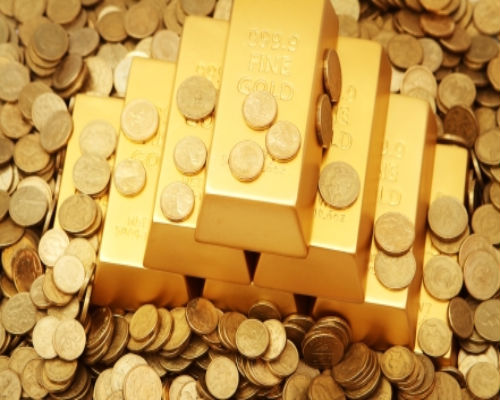fjrigjwwe9r3SDArtiMast:ArtiCont
ize=4 face="times new roman, times, serif">Gold aids portfolio diversification, insuring it against market vagaries. Euro crisis and Chinese demand are only likely to make it more precious.
Are investors getting nervous about the future prospects of gold? May be a little, considering the price of the yellow metal is hovering around its all-time high. Mumbai standard gold prices have gone up from . 22,335 for 10 gram to . 29,680 in the last year, an appreciation of 32.88%. Investors were also betting on gold. According to AMFI data, value of gold holdings in gold exchange traded funds (ETFs) have gone up from . 5,463 crore to . 10,312 crore in the last one year.
|
 |
Lately, however, the situation seems to have changed a little. Gold ETFs have seen net outflow of . 41 crore in May, says AMFI. That raises a question: should one buy gold at these current high prices? “Investors must look at gold from the portfolio diversification point of view. Gold prices should remain firm, considering the high deficits of governments across the world and the sovereign debt crisis,” says Chirag Mehta, fund manager – commodities, Quantum AMC.
THE INDIAN SCENARIO
Another factor that is working in favour of the precious metal is the persistent weakness in the Indian currency. Gold, which was quoting at $1,621 per ounce on August 1, 2011, was priced at $1,571 per ounce on June 8, a loss of 3%. But, if you look at the rupee price of gold during this period, the price has moved from . 23,150 to . 29,680 per 10 gram, a gain of 28%. This gain is explained by the 26.19% fall in the rupee against the dollar in the same period. The rupee fell from . 44.07 per USD to . 55.62. The surge in gold prices in rupee term is an outcome of the rupee’s depreciation than any increase in demand for the yellow metal. “If gold prices remain firm, demand for gold from India should go down. At the same time, strong gold prices should increase the supply of scrap gold, thereby influencing gold prices downwards,” points out Devendra Nevgi, founder & partner, Delta Global Partners.
In FY2011-2012, India imported gold worth $56 billion. Since India’s current account deficit for the year was estimated at $74 billion, the government may introduce tax for gold imports to contain the deficit. While this should drive prices up in the short term, in the medium term, the demand for gold would come down.
Quantitative easing by developed nations typically increases risk appetite of global investors. Carry trade — where investors borrow at a low interest rate in one country and invest for a higher rate of return in another — picks up. Given the attractive equity valuations, the Indian markets may see inflow of funds. This will increase the demand for the rupee against the US dollar. A strong rupee may curb the rupee prices when compared with the dollar prices. Quantitative easing, thus, will have a balancing effect on gold prices — while on the one hand it may push up the dollar prices of the precious metal, on the other, it may reduce the rupee prices as rupee strengthens.
THE GLOBAL SCENARIO
International macroeconomic events are the chief drivers of gold prices in dollar terms. “Gold prices are expected to go up in dollar terms due to the sovereign debt crisis in Europe and a possible quantitative easing,” says Nevgi. Speculation over Greece’s exit from Euro is one of the reasons driving the demand for gold. If a larger economy such as Spain defaults on its borrowing, investors may buy gold in larger quantities as the stability of Euro as a currency may be questioned. Worsening sovereign debt crisis is a catalyst for increasing gold demand and is, thereby, supportive of gold prices. Quantitative easing done by central banks to boost economy ensures more money in the financial system. It leads to inflation as more money chases existing assets in the economy. Investors prefer to keep gold in their portfolio as a natural hedge against inflation. These two factors are driving the investment demand for gold. But one must have a look at the consumption demand, too.
India has been the leader when it comes to consumption demand for the yellow metal. However, things are changing. As price climbs, the Indian appetite for gold goes down. According to World Gold Council data for 1Q2012, India’s gold demand for jewellery, and bars and coins fell by 29% in tonnage terms — it stood at 207.6 tonnes against 290.6 tonnes in1Q2011. But the dollar prices of gold have got a new driver. The consumption demand from Greater China has seen a jump of 10%, from 243.4 tonnes in 1Q2011 to 265.7 tonnes in 1Q2012. As Chinese consumption is expected to grow at a healthy rate, gold prices should continue to climb in dollar terms.
OUTLOOK
Experts reckon the importance of gold as insurance for a portfolio and making it a mandatory component of your portfolio irrespective of the price levels. But there are many who want to take a tactical bet on gold. For them, the price matters. Though most experts feel gold should go up from here given the poor macro economic scenario, not many are keen on putting a price tag based on fundamentals. “If gold prices are resilient enough to sustain and not breach $1,530, we may witness a sharp rally, which can extend up to $1,710 or even up to $1,790 in the near term. Otherwise, a slip towards $1,510 will be seen,” says Basant Vaid, senior research analyst, Bonanza Portfolio. “In the Indian market, . 28,850 is a strong support. “If the support cracks, gold prices can tumble towards . 27,900-odd levels or else a rally towards a new life-time high can be seen.”